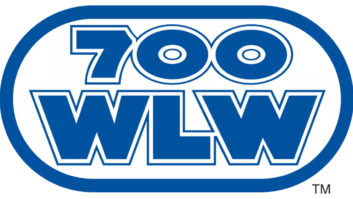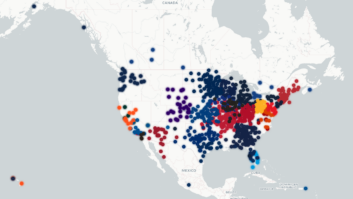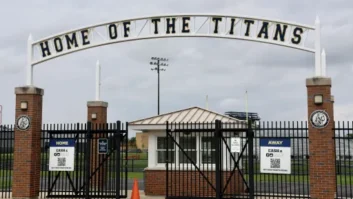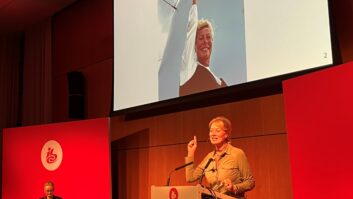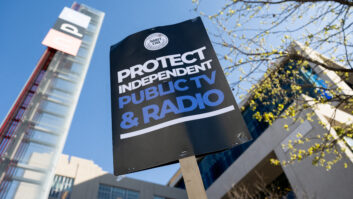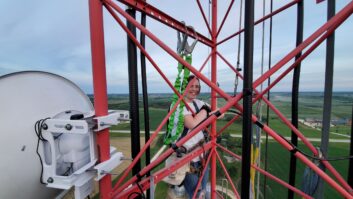(click thumbnail)Big Jim Williams today I received my first full-time announcing job in 1951 at KVVC(AM) in Ventura, Calif.
We were a 1,000-watt directional station (two towers) broadcasting from a bean field on the edge of town. The cramped studio transmitter building, a cracker box block structure with a flat roof and dusty parking, also housed our manager, offices and sales staff.
There I was, trusted behind a microphone, operating a transmitter as a “combo-man.” I loved every minute reading commercials and news, playing 78 rpm records, and 16-inch electrical transcriptions (ET) where I got to say, like the big-voiced announcers on the networks: “The following program is transcribed.”
Re-creating the big game
In the early ’50s, Ventura had a professional baseball team, a farm club, in the California C League. We broadcast games live via telephone lines from Ventura’s Seaside Park, and when Ventura played nearby Santa Barbara. League teams were spread throughout California.
When baseball games were played “on the road,” we “re-created” them, using a Western Union observer tapping his telegrapher’s key at away games. Another WU employee, in our station, translated the dots-and-dashes into an abbreviated script. Our broadcasts usually began about 30-minutes after the actual start of the game.
Re-creations avoided the expense of transporting our KVVC sportscaster to away games, and paying for broadcast phone lines from distant ballparks.
For re-creations, I ran the station’s master control board, provided background “crowd noise” from 16-inch ETs, and — from our limited sound-effects library — clapping, cheering or booing when needed, while our play-by-play man (John McCormick or Jim Deering) re-created the game behind glass in Studio A.
A baseball bat hung from the ceiling where the sportscaster struck it with a wooden ruler to duplicate hitting a ball. A baseball glove in his left hand and a ball in his right hand replicated catching a pitched ball. It all helped to make our re-creations sound like we were actually in a ballpark. I loved it.
A small speaker behind the sportscaster allowed me, through a separate microphone, to sound like the ballpark’s PA announcer, thus adding additional authenticity to our broadcasts. “At bat is …”
I occasionally added a recorded voice in the background, shouting: “Get your peanuts, here. Get your red hot peanuts.”
I also read the commercials, of which there were few because listeners and advertising dollars were being siphoned off by the new medium of television.
Although we began and closed such broadcasts with disclaimers, we frequently received calls from listeners, arguing (often betting) with friends, ”Is this game live?” Most calls came from bars.
A fine art
One night Ventura played at Modesto. We had a telegrapher, Harry Parsons, in our station accepting dot-and-dasher signals from his counterpart in the press box in Modesto. The away telegrapher opened with player lineups and positions, and added something like, “… 85 degrees … cloudy … rain possible … wind 5 mph from SW … 587 in stands.”
When play began, a simple outline of each half inning followed. “Ventura up. Sam Jones, left fielder, at bat. S-1 … swings high. B-2 … low. S-2 … no swing. Hits deep to right field … Rollins stops on first bounce … throws to first … close, but safe. Fans boo ref.”
After typing up a half inning of play, Harry silently entered Studio A and gave the original to our sportscaster and a carbon copy to me.
The sportscaster could then ad-lib the game, adding background and color as needed to slow or speed up the action. After working together on several broadcasts, we had re-creations down to a fine art.
However, the night we played Modesto, everything went wrong, worse than Earnest Thayer’s poem, “Casey at the Bat.”
About three innings into the game, Harry rushed into master control, shaking his head. “I don’t know what’s going on up there, but something’s weird,” he said.
He handed me the script he’d just typed. “Look, at this, Jim.”
I did. Modesto had had four outs, retired its side and then come right back up to bat again.
“This is crazy,” said Harry.
Our confused sportscaster wasn’t sure what to do. He began sweating, ad-libbing about the weather, the crowd, the players, the crowd, his kids, the crowd, his WWII experiences and making up stories about the ballpark’s peanut vendors or arguments or fights in the stands; anything to kill time. He was desperate. There he was with an open microphone, and a telegrapher’s script that didn’t make sense.
There was always the ploy he had used before: “The groundskeepers need to drag the field,” or, “it’s suddenly raining here,” or “the stadium lighting has gone out,” or “we’re getting a dust storm, so back to the studio for some music.”
I filled with music while Harry hurriedly phoned the press box in Modesto. The phone rang and rang before the telegrapher answered with hiccups and slurred speech. He was drunk.
Harry was suddenly faced with getting information (begging is a better word) from a reporter covering the game for the Modesto Bee newspaper. Working hurriedly, Harry typed a new cue sheet, picking up action prior to where Modesto supposedly had “four outs.”
After about 20 minutes of music, we returned to the re-creation and eventually finished the broadcast.
Don’t ask me who won, because I don’t remember. But the Modesto telegrapher got fired.
It was a terrible evening. Now, more than 50 years later, it comes back as one of the most memorable events of my long career in small-town radio.
However, it may have been the night I took up drinking. I know the sportscaster did.

